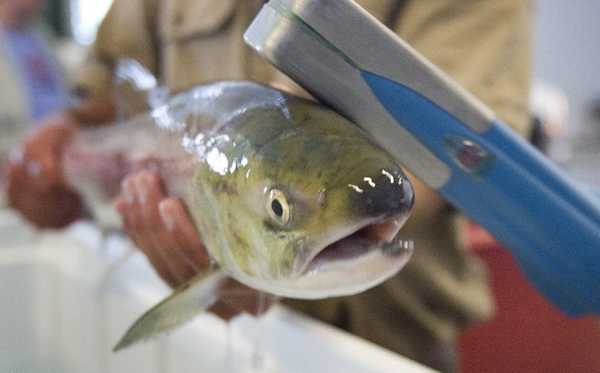forum
library
tutorial
contact

Sockeye Numbers Reach
Highest Level in Decades
by Jason KauffmanIdaho Mountain Express, August 20, 2008
|
the film forum library tutorial contact |

|
Sockeye Numbers Reach
by Jason Kauffman |
A total of 386 sockeye salmon had arrived in the Sawtooth Valley by Tuesday
 As of Tuesday morning, 386 sockeye salmon had arrived at one of two fish traps near the Sawtooth Fish Hatchery along the upper Salmon River northwest of Ketchum, fisheries officials reported yesterday afternoon. In all, a total of 42 sockeye arrived in the Sawtooth Valley on Tuesday.
As of Tuesday morning, 386 sockeye salmon had arrived at one of two fish traps near the Sawtooth Fish Hatchery along the upper Salmon River northwest of Ketchum, fisheries officials reported yesterday afternoon. In all, a total of 42 sockeye arrived in the Sawtooth Valley on Tuesday.
This summer's run is the now the highest run of sockeye since biologists started tracking those arriving in the Sawtooth Valley in 1985. The previous record holder in recent decades was in 2000 when 257 of the famous red fish made their way back.
According to fisheries biologists with the Idaho Department of Fish and Game, the 2008 run is an indication that the agency's captive broodstock program for Snake River sockeye salmon is beginning to reap benefits.
"The sockeye program is definitely going in the right direction," said Travis Brown, assistant manager of the Eagle Fish Hatchery. Brown was at the Sawtooth hatchery to help out with the processing of captured sockeye, which are being sent to the Eagle hatchery, site of the state's captive-breeding program.
In recent years, returns of sockeye have varied wildly in the upper Salmon River. Anadromous fish must cross eight major dams on the Columbia and lower Snake rivers before they reach Idaho.
Hundreds of miles downriver from the Sawtooth Valley on Tuesday, 881 adult sockeye salmon had passed by the Lower Granite Dam, the last barrier on the lower Snake River in southeast Washington that anadromous fish must pass before entering Idaho.
Though this summer's run is indeed a remarkable improvement above mostly dismal single-digit or nonexistent sockeye returns to Redfish Lake during the past several decades, the Sawtooth Valley sockeye population is far from recovered, fisheries officials have said. In the mid-1950s, thousands of the fish returned to spawn in Redfish, Petit, Alturas and other lakes in the shadow of the Sawtooth Mountains.
From eggs produced by the state's captive broodstock program, 355 hatchery-produced sockeye returned to the Sawtooth Valley during an eight-year period between 1999 and 2007. By comparison, just 77 natural-origin sockeye salmon returned to Idaho in the 14-year period between 1985 and 1998.
This year's positive sockeye returns have been attributed to good smolt production four years ago, good out-migration conditions in the rivers and excellent ocean conditions.
Redfish Lake sockeye salmon (Oncorhynchus nerka) were listed as endangered under the federal Endangered Species Act in November 1991. They were the first Idaho salmon to be listed. Redfish Lake sockeye are unique in that they travel to the highest elevation, over 6,500 feet, run the longest distance, about 900 miles, and travel the farthest south of any North American sockeye population.
This year's returns are the result of 180,000 smolts that were released and migrated to the ocean in 2006, Eagle hatchery Conservation Hatcheries Supervisor Jeff Heindel said last month.
Related Pages:
F&G Management Plans Helping in the Sockeye Recovery by Cal Groen, Idaho Statesman, 8/12/8
Don't Equate Strong Sockeye Return with Recovery by Rocky Barker, Idaho Statesman, 8/10/8
learn more on topics covered in the film
see the video
read the script
learn the songs
discussion forum
